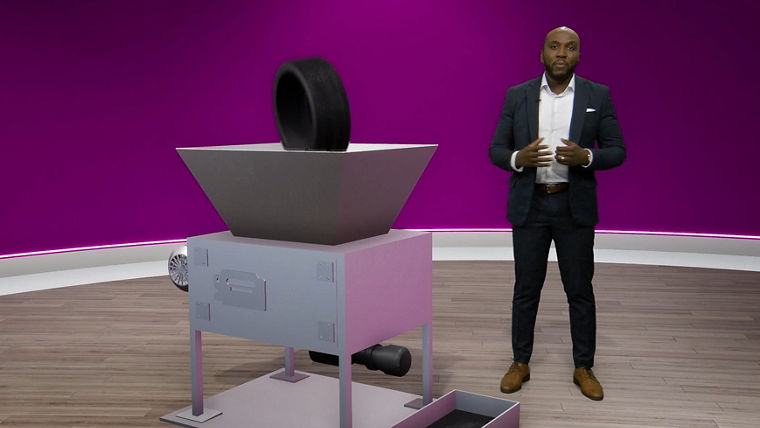It was a milestone in chemistry when, 180 years ago, Charles Goodyear and Thomas Hancock independently succeeded in producing elastic and hard-wearing rubber from floppy coagulated latex. They called their process vulcanization because heat and sulfur were involved. Rubber then rapidly took off and is now an integral part of everyday life. The most important products made from this all-round material include tires, without which mobility on our roads would be impossible.
There are around 1.6 billion vehicles on the road worldwide that need to be fitted with tires several times in their lifetime. In 2023, almost 1.8 billion tires were produced and a similar number of end-of-life tires were removed from the rims forever at the same time.
Ideally, the material from the worn-out tires would be used as a raw material for their successors. End-of-life tires are easy to collect and, unlike most synthetic materials, are available as a monomaterial. So why not simply melt down the rubber components and use them for new tires? Unfortunately, this is not possible. Vulcanization has a downside—to date, chemically reversing the process requires great effort.

FROM WASTE TO RAW MATERIAL
For a long time, worn-out tires were considered waste. In the 1990s, a large proportion still ended up in landfill sites, even in Europe. The rest were mostly incinerated—to generate energy in cement works, for example. At some point, people came up with the idea of shredding and grinding old tires. Since then, however, the rubber powder produced in this way has mainly been used in road surfaces, sports surfaces, and building materials.
But reusing this tire rubber for new tires is the exception, not the rule. “Industry experts estimate that tire manufacturers replace at most five percent of the rubber in their formulations with recycled rubber powder,” says the chemist Dr. Christian Mani from Creavis. More, it is said, could impair the properties of the tires.
However, a lot has been happening in the industry in recent years: Virtually all globally operating tire manufacturers have set themselves ambitious sustainability targets and want to significantly increase the proportion of renewable and recycled materials in their formulations. At the beginning of 2023, a US manufacturer presented a demonstration tire consisting of 90 percent sustainable raw materials, with at least seven percent coming from end-of-life tires, according to the company. Many manufacturers are clearly aiming to close material cycles.

However, there are many technical challenges along the way. This is because incorporating old rubber into new is still a complicated matter. The properties of the material produced in this way do not come close to those of rubber made exclusively from new raw materials. According to Christian Mani, this is mainly due to the fact that the molecules from the recycled rubber powder hardly form crosslinks with new material during the revulcanization process, resulting in potential weak points. To change this, the molecular network in the old rubber would first have to be broken up, i.e. devulcanized (see the infographic)
Broken Bridges

This is exactly what Mani is working on. He has been researching recycling concepts for polymer materials at Creavis, Evonik’s strategic innovation unit in Marl, for several years. One of his projects revolves around end-of-life tires and how to at least partially reverse the vulcanization process in the rubber they contain. He and his team want to multiply the current proportion of recycled rubber in new tires.

A PROMISING CANDIDATE
Researchers in many places are currently working on devulcanization. However, they haven’t yet found an approach that would lead to broad industrial application. Thermomechanical processes, for example, have unwanted side effects on the molecular network in used rubber. Chemical additives are therefore used in an attempt to better control the reaction process and steer it in the right direction. Such additives are called devulcanization agents. “Some substances already do this quite well, but unfortunately they are toxic or cause undesirable odors in the final rubber product,” says Dr. Wilma Dierkes, Associate Professor at the University of Twente in Enschede, where she has been working on devulcanization for over 20 years. Her research department has been cooperating with Mani’s Evonik team for several years.
During this collaboration, they have discovered a candidate material that meets many requirements and avoids the disadvantages of previous devulcanization agents. Its main component is a vinylsilane—a compound in which a central silicon atom forms one of its bonds to a vinyl group. Because this is quite reactive, the vinylsilane can serve as a radical scavenger during devulcanization. “Radicals form when the sulfur bridges break,” explains Mani. “Molecular ends remain on both sides. These are so reactive that they immediately form new bonds.”
Devulcanization agents chemically seal these molecule ends and eliminate their reactivity. “The vinyl group in our silane prevents reverse crosslinking,” says Mani. At the same time, the vinylsilane is there to scavenge any radicals that can break up the rubber polymer chains—and thus prevent an unwanted side effect.

Devulcanization agents chemically seal these molecule ends and eliminate their reactivity. “The vinyl group in our silane prevents reverse crosslinking,” says Mani. At the same time, the vinylsilane is there to scavenge any radicals that can break up the rubber polymer chains—and thus prevent an unwanted side effect.
Vinylsilane also fulfills another function that is particularly important in the recycling of car tires. In contrast to truck tires, for example, these contain a chemically bound filler in their tread rubber: silica. “For recycling, it is very important to reactivate this silica so that it can form new chemical bonds during the new vulcanization process,” explains Mani. This is exactly what a vinylsilane does.
To find out how well a devulcanization agent does its job, a series of tests are necessary: on the one hand with the devulcanized material and, on the other hand, with the new rubber that has been manufactured using the devulcanized material.
To conduct such investigations, Christian Mani repeatedly travels to Wesseling, south of the city of Cologne, Germany, where Evonik’s Tire & Rubber Application Technology unit is located. Among other things, it develops silica products for car tires and produces samples for test purposes.
Mani now also uses the necessary test infrastructure, which can produce rubber parts with any formulation. Moreover, it is possible to directly examine the properties of the resulting rubber.

TESTS WITH RUBBER DUMBBELLS
On this sunny day, Christian Mani is once again in the test laboratory. Together with Dr. Jens Kiesewetter, Head of Application Technology Wesseling, he looks at an apparatus that is currently stretching a black, dumbbell-shaped rubber part. A monitor next to it shows a diagram in which the force applied is plotted against the elongation length of the rubber part: a line that continues to rise.
When the rubber dumbbell has almost doubled in length, it tears in the middle. At that moment, the curve on the monitor drops straight down. “That was the elongation at break,” says Kiesewetter, explaining that the tensile strength can be calculated from the force applied at the end and the maximum elongation of the rubber achieved.

After Mani and Kiesewetter have checked the values, it’s on to the next test setup. “Our rubber samples contain different proportions of devulcanized material, and we want to see how these proportions affect their properties,” explains Mani. In addition to tensile strength, these include hardness and the homogeneity of the material.
In their tests, the researchers use a formulation for the tread rubber of car tires because this is one of the most demanding tire components. Here, it’s important to know that although a tire is made of rubber throughout, the formulations for the individual components such as tread, carcass, sidewall, bead or inner coating are all different, for example in terms of the type of rubber used.
The tread must meet the highest requirements, because it guarantees the safety of the vehicle. “If a devulcanized material works in this component, then it will most likely also be suitable for some of the other tire parts,” says Wilma Dierkes from the University of Twente.

THE GOAL IS 20 PERCENT
“Laboratory tests to date indicate that up to 20 percent of the rubber can be replaced by devulcanized material and that the rubber produced in this way would still meet the high quality requirements of tire manufacturers,” says Christian Mani. That would be roughly a fourfold increase compared to the quantities of rubber powder that tire manufacturers currently incorporate into their formulations.
Mani explains that this great increase is made possible by the successful breaking of both the sulfur bridges and the bonds between the filler and the polymer network. As a result, the double bonds still present in the rubber chains become more accessible and can be used for crosslinking during the new vulcanization process.
THE PATH TO INDUSTRIAL APPLICATION
Despite the successes to date, it is still too early to approach tire manufacturers with this technique, says Mani. “Up to now, our devulcanized materials have come from laboratory tests. We are currently trying to ensure that the properties are also guaranteed when we devulcanize in larger plants, as would be necessary for an industrial application.”
This also means that it is not yet possible to say in which tire components and to what extent manufacturers will later incorporate the devulcanized material. If it really is 20 percent in the demanding tread rubber, recycling researcher Wilma Dierkes can even imagine that the recycling rate in other tire components could be higher.

And there is something else that needs to be tested in advance: For a long time, Mani and his team produced the rubber for their tests themselves in the technology center. In industrial practice, the material would come directly from companies that process end-of-life tires. Although these companies separate the steel and textile parts contained in the tire, they cannot separate the different types of rubber in the carcass, sidewall or tread. Rubber powder from end-of-life tires is therefore a mixture. The Evonik researchers led by Mani are currently testing whether their proven method for defined rubber is also suitable for this purpose. To find out if this is the case, Mani will be relying on the support of Jens Kiesewetter and his team for some time to come.
Neither Charles Goodyear nor Thomas Hancock probably ever dreamed that one day the goal would be to reverse the vulcanization process that they had developed with great effort and setbacks. However, they didn’t have to worry about raw material shortages, sustainability, and recycling concepts. Today all that has changed. For Christian Mani, it would therefore be a great success if one day a product developed by his team enabled Evonik to keep significantly more tire rubber in circulation than before.
ELEMENTS-Newsletter
Receive exciting insights into Evonik's research and its social relevance - conveniently by e-mail.


